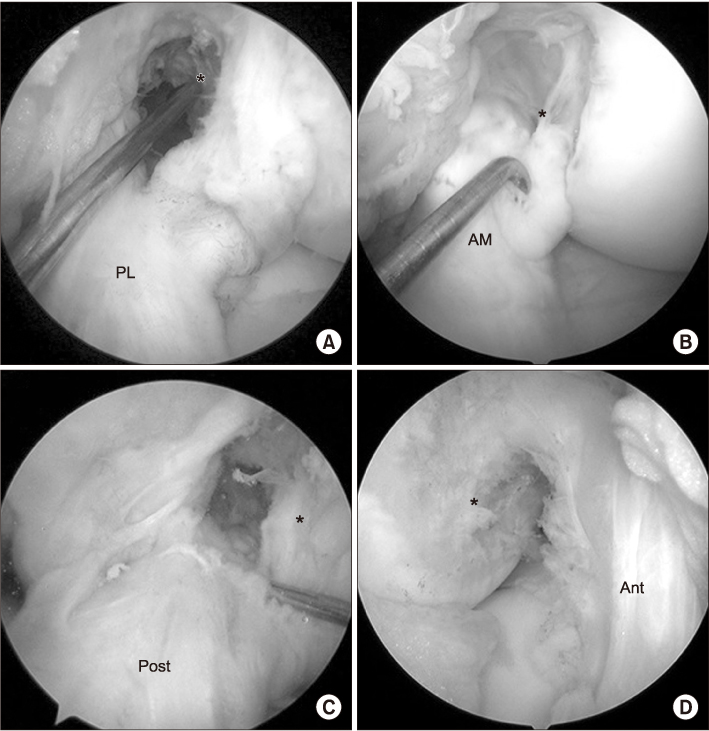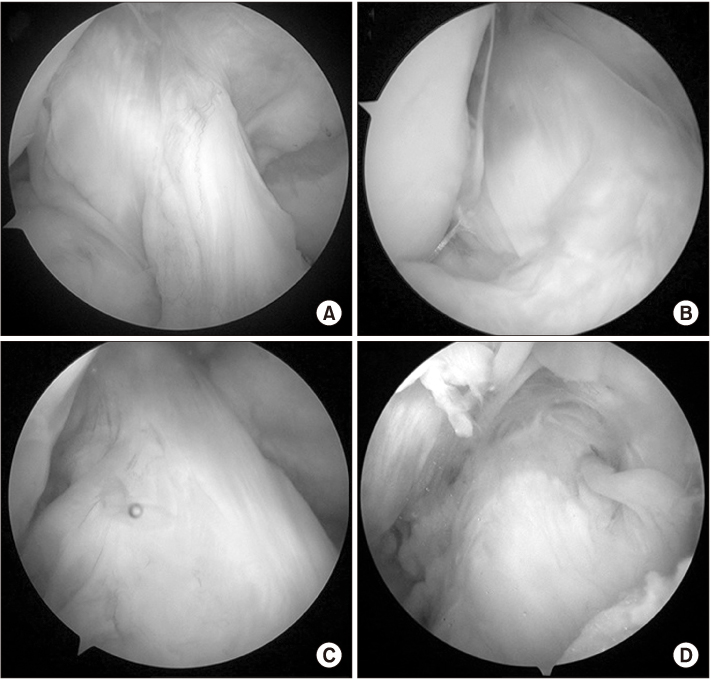J Korean Orthop Assoc.
2019 Dec;54(6):537-546. 10.4055/jkoa.2019.54.6.537.
Clinical Results of Footprint Restoration Anterior Cruciate Ligament Reconstruction with Remnant Preservation
- Affiliations
-
- 1Department of Orthopaedic Surgery, Hallym University Dongtan Sacred Heart Hospital, Hwaseong, Korea. yjseo-os@hanmail.net
- KMID: 2469885
- DOI: http://doi.org/10.4055/jkoa.2019.54.6.537
Abstract
- PURPOSE
Anteromedial (AM), posterolateral (PL), anterior, and posterior remnant preserving anterior cruciate ligament (ACL) reconstructions were conducted on patients with partial ACL tears based on the arthroscopic findings. The clinical results of the four groups were compared.
MATERIALS AND METHODS
This study included 98 patients who underwent a remnant preserving ACL reconstruction from January 2013 to June 2016 and could be followed-up for at least two years. The subjects were categorized into four groups according to the selective bundles reconstructed: group A, anteromedial selective bundle reconstruction; group B, posterolateral selective bundle reconstruction; group C, anterior bundle reconstruction; and group D, posterior bundle reconstruction. The preoperative and postoperative anterior translation from the stress X-ray, International Knee Documentation Committee Subjective Knee Form (IKDC SKF) score, Lysholm score, and hospital for special surgery (HSS) score were compared.
RESULTS
All four groups showed significant improvement in anterior translation on the stress X-ray conducted with knees at 15° flexion, IKDC SKF score, Lysholm score, and HSS score postoperatively (in all groups, p < 0.001). No intergroup differences were observed in terms of the functional outcomes except that preoperative IKDC SKF score was higher in the C group than in the A group (p=0.021), and the preoperative Lysholm score was higher in the B group than in the A group (p=0.03).
CONCLUSION
After the AM, PL, anterior, and posterior remnant preserving ACL reconstructions, all four groups showed satisfactory results in terms of the anteroposterior stability and functional knee scores with no significant intergroup differences.
Figure
Reference
-
1. van Eck CF, Fu FH. Anatomic anterior cruciate ligament reconstruction using an individualized approach. Asia Pac J Sports Med Arthrosc Rehabil Technol. 2014; 1:19–25.
Article2. Crain EH, Fithian DC, Paxton EW, Luetzow WF. Variation in anterior cruciate ligament scar pattern: does the scar pattern affect anterior laxity in anterior cruciate ligament-deficient knees? Arthroscopy. 2005; 21:19–24.
Article3. Yoo YS, Song SY, Yang CJ, Ha JM, Kim YS, Seo YJ. A comparison between clinical results of selective bundle and double bundle anterior cruciate ligament reconstruction. Yonsei Med J. 2016; 57:1199–1208.
Article4. Śmigielski R, Zdanowicz U, Drwięga M, Ciszek B, Ciszkowska-Łysoń B, Siebold R. Ribbon like appearance of the midsubstance fibres of the anterior cruciate ligament close to its femoral insertion site: a cadaveric study including 111 knees. Knee Surg Sports Traumatol Arthrosc. 2015; 23:3143–3150.
Article5. Gobbi A, Mahajan V, Karnatzikos G, Nakamura N. Single-versus double-bundle ACL reconstruction: is there any difference in stability and function at 3-year followup? Clin Orthop Relat Res. 2012; 470:824–834.6. Ahn JH, Choi SH, Wang JH, Yoo JC, Yim HS, Chang MJ. Outcomes and second-look arthroscopic evaluation after double-bundle anterior cruciate ligament reconstruction with use of a single tibial tunnel. J Bone Joint Surg Am. 2011; 93:1865–1872.
Article7. Muneta T, Koga H. Anterior cruciate ligament remnant and its values for preservation. Asia Pac J Sports Med Arthrosc Rehabil Technol. 2016; 7:1–9.
Article8. Georgoulis AD, Pappa L, Moebius U, et al. The presence of proprioceptive mechanoreceptors in the remnants of the ruptured ACL as a possible source of re-innervation of the ACL autograft. Knee Surg Sports Traumatol Arthrosc. 2001; 9:364–368.
Article9. Gao F, Zhou J, He C, et al. A morphologic and quantitative study of mechanoreceptors in the remnant stump of the human anterior cruciate ligament. Arthroscopy. 2016; 32:273–280.
Article10. Sha L, Xie G, Zhao S, Zhao J. A morphologic and quantitative comparison of mechanoreceptors in the tibial remnants of the ruptured human anterior cruciate ligament. Medicine (Baltimore). 2017; 96:e6081.
Article11. Sun L, Wu B, Tian M, Liu B, Luo Y. Comparison of graft healing in anterior cruciate ligament reconstruction with and without a preserved remnant in rabbits. Knee. 2013; 20:537–544.
Article12. Wu B, Zhao Z, Li S, Sun L. Preservation of remnant attachment improves graft healing in a rabbit model of anterior cruciate ligament reconstruction. Arthroscopy. 2013; 29:1362–1371.
Article13. Takahashi T, Kondo E, Yasuda K, et al. Effects of remnant tissue preservation on the tendon graft in anterior cruciate ligament reconstruction: a biomechanical and histological study. Am J Sports Med. 2016; 44:1708–1716.14. Kim MK, Lee SR, Ha JK, Ra HJ, Kim SB, Kim JG. Comparison of second-look arthroscopic findings and clinical results according to the amount of preserved remnant in anterior cruciate ligament reconstruction. Knee. 2014; 21:774–778.
Article15. Lee YS, Nam SW, Sim JA, Lee BK. Comparison of anatomic ACL reconstruction between selective bundle reconstruction and double-bundle reconstruction. Knee Surg Sports Traumatol Arthrosc. 2014; 22:2803–2810.
Article16. Abat F, Gelber PE, Erquicia JI, Pelfort X, Tey M, Monllau JC. Promising short-term results following selective bundle reconstruction in partial anterior cruciate ligament tears. Knee. 2013; 20:332–338.
Article17. Steckel H, Vadala G, Davis D, Fu FH. 2D and 3D 3-tesla magnetic resonance imaging of the double bundle structure in anterior cruciate ligament anatomy. Knee Surg Sports Traumatol Arthrosc. 2006; 14:1151–1158.
Article18. Steckel H, Vadala G, Davis D, Musahl V, Fu FH. 3-T MR imaging of partial ACL tears: a cadaver study. Knee Surg Sports Traumatol Arthrosc. 2007; 15:1066–1071.
Article19. Li H, Tao H, Cho S, Chen S, Yao Z, Chen S. Difference in graft maturity of the reconstructed anterior cruciate ligament 2 years postoperatively: a comparison between autografts and allografts in young men using clinical and 3.0-T magnetic resonance imaging evaluation. Am J Sports Med. 2012; 40:1519–1526.
- Full Text Links
- Actions
-
Cited
- CITED
-
- Close
- Share
- Similar articles
-
- The Effect of a Tibial Remnant Preservation Technique on the Synovialization of the Graft Tendon in Anterior Cruciate Ligament Reconstruction: Based on the Second Look Arthroscopic Findings
- Double-Bundle Anterior Cruciate Ligament Reconstruction
- Femoral Footprint for Anatomical Single-Bundle Anterior Cruciate Ligament Reconstruction: A Cadaveric Study
- What Has Been Learned in Anterior Cruciate Ligament Reconstruction during the Past 20 Years?
- Ligament Reconstruction in Congenital Absence of the Anterior Cruciate Ligament: A Case Report




